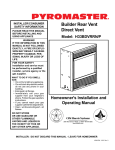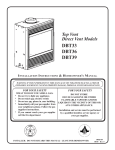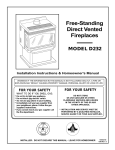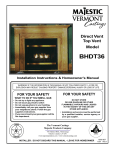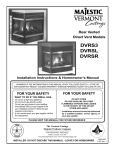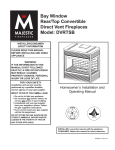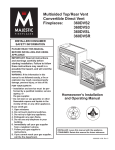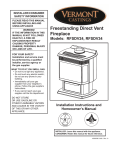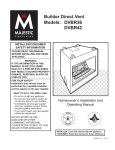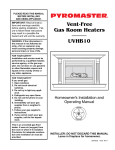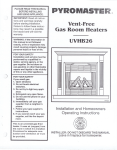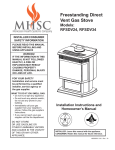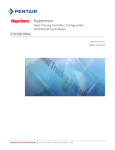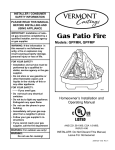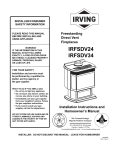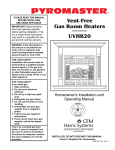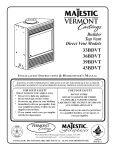Download Vermont Castings H33BDVRRN Operating instructions
Transcript
INSTALLER/CONSUMER SAFETY INFORMATION Builder Rear Vent Direct Vent PLEASE READ THIS MANUAL BEFORE INSTALLING AND USING APPLIANCE Model: H33BDVRRN/P WARNING! IF THE INFORMATION IN THIS MANUAL IS NOT FOLLOWED EXACTLY, A FIRE OR EXPLOSION MAY RESULT CAUSING PROPERTY DAMAGE, PERSONAL INJURY OR LOSS OF LIFE. FOR YOUR SAFETY Installation and service must be performed by a qualified installer, service agency or the gas supplier. WHAT TO DO IF YOU SMELL GAS: • Do not try to light any appliance. • Do not touch any electric switch; do not use any phone in your building. • Extinguish all flames. • Immediately call your gas supplier from your neighbor's phone. Follow the gas suppliers instructions. • If you cannot reach your gas supplier call the fire department. • Open windows/extinguish all flames. DO NOT STORE OR USE GASOLINE OR OTHER FLAMMABLE VAPORS AND LIQUIDS IN THE VICINITY OF THIS OR ANY OTHER APPLIANCE. Homeowner's Installation and Operating Manual DE S I GN CFM Harris Systems CE RTIFI E D C E RT I F I E D 3501 West Howard • Skokie, IL 60076 • 847-676-3556 www.cfmharris.com INSTALLER: DO NOT DISCARD THIS MANUAL - LEAVE FOR HOMEOWNER 10004798 11/02 Rev. 0 Downloaded from www.Manualslib.com manuals search engine Pyromaster© H33BDVRRN/P Table of Contents Please read the installation & operating instructions before using appliance Thank you and congratulations on your purchase of a CFM Harris Systems fireplace. IMPORTANT: Read all instructions and warnings carefully before starting installation. Failure to follow these instructions fully may result in a possible fire hazard and will void the warranty. Installation & Operating Instructions ........................................................................................... 3 Locating Your Fireplace .................................................................................................... 3 Fireplace Dimensions ......................................................................................................... 4 Clearance to Combustibles ................................................................................................ 5 Mantels .............................................................................................................................. 5 Hearth .............................................................................................................................. 5 Framing & Finishing ........................................................................................................... 6 Final Finishing .................................................................................................................... 6 Gas Specifications ............................................................................................................. 6 Gas Inlet and Manifold Pressures.................................................................................... .. 6 High Elevations .................................................................................................................. 6 Gas Line Installation ........................................................................................................... 6 Remote ON/OFF Switch .................................................................................................... 7 Alternate Switch Location ................................................................................................... 7 Venting Installation Instructions General Venting Information-Termination Location ........................................................... 7 General Information on Assembling DV Components ....................................................... 9 Crimped End Pipes ............................................................................................................ 9 Twist Lock Pipes .............................................................................................................. 10 How to Use the Vent Graph...................................... ....................................................... 10 Rear Wall Vent Applications & Installation ....................................................................... 10 Vertical Sidewall Applications & Installation ..................................................................... 12 Below Grade Installations.. .............................................................................................. 15 Vertical Through-the-Roof Applications & Installation ...................................................... 16 Twist Lock Venting Components ...................................................................................... 18 Crimped End Venting Components .................................................................................. 19 Operating Instructions Glass Information ............................................................................................................. 20 Louvre Removal ............................................................................................................... 20 Window Frame Assembly Removal ................................................................................. 20 Glass Cleaning ................................................................................................................. 20 Installation of Logs, Lava Rock & Ember Material ........................................................... 20 Flame & Temperature Adjustment ................................................................................... 21 Flame Characteristics ...................................................................................................... 21 Lighting Instructions ......................................................................................................... 22 Trouble Shooting .............................................................................................................. 24 Fuel Conversion Instructions ............................................................................................ 25 Maintenance ............................................................................................................................ 25 Replacement Parts ....................................................................................................................... 26 Optional Accessories Fan Kits ............................................................................................................................ 28 Wiring Instructions ............................................................................................................ 29 EB-1 Electrical Box .......................................................................................................... 29 Ceramic Refractory Kits ................................................................................................... 29 Decorative Bay Windows ................................................................................................. 30 Bay Window Screen ......................................................................................................... 31 Remote Controls .............................................................................................................. 31 Trim Kit ............................................................................................................................. 31 2 Downloaded from www.Manualslib.com manuals search engine 10004798 Pyromaster© H33BDVRRN/P Installation & Operating Instructions This gas appliance should be installed by a qualified installer in accordance with local building codes and with current CSAB149.1 Installation codes for Gas Burning Appliances and Equipment. For USA Installations follow local codes and/or the current National Fuel Gas Code. ANSI Z223.1. FOR SAFE INSTALLATION AND OPERATION PLEASE NOTE THE FOLLOWING: 1 . This fireplace gives off high temperatures and should be located out of high traffic areas and away from furniture and draperies. 2. Children and adults should be alerted to the hazards of high surface temperatures of this fireplace and should stay away to avoid burns or ignition of clothing. 3. CAUTION: Due to high glass surface temperature children should be carefully supervised when in the same room as fireplace. 4. Under no circumstances should this fireplace be modified. Parts removed for servicing should be replaced prior to operating this fireplace again. 5. Installation and any repairs to this fireplace must be performed by a qualified installer, service agency or gas supplier. A professional service person should be contacted to inspect this fireplace annually. Make it a practice to have all of your gas fireplaces checked annually. More frequent cleaning may be required due to excess lint and dust from carpeting, bedding material, etc. 6. Control compartments, burners and air passages in this fireplace should be kept clean and free of dust and lint. Make sure the gas valve and pilot light are turned off before you attempt to clean this fireplace. 7. The venting system (chimney) of this fireplace should be checked at least once a year and if needed your venting system should be cleaned. 8. Keep the area around your fireplace clear of combustible materials, gasoline and other flammable vapor and liquids. This fireplace should not be used as a drying rack for clothing, nor should Christmas stockings or decorations be hung on or around the fireplace. 9. Under no circumstances should any solid fuels (wood, coal, paper or cardboard etc.) be used in this fireplace. 10.The flow of combustion and ventilation air must not be obstructed in any way. 11.When fireplace is installed directly on carpeting, vinyl tile or any combustible material other than wood, the fireplace must be installed on a metal or wood panel extending the full width and depth of the fireplace. 12.This fireplace requires adequate ventilation and combustion air to operate properly. 13. This fireplace must not be connected to a chimney flue serving a separate solid fuel burning fireplace. 14. When the fireplace is not in use it is recommended that the gas valve be left in the OFF position. Proposition 65 Warning: Fuels used in gas, woodburning or oil fired appliances, and the products of combustion of such fuels, contain chemicals known to the State of California to cause cancer, birth defects and other reproductive harm. California Health & Safety Code Sec. 25249.6 10004798 Downloaded from www.Manualslib.com manuals search engine This appliance has been approved for after-market mobile home installations IMPORTANT: PLEASE REVIEW THE FOLLOWING CAREFULLY Remove any plastic from trim parts before turning the fireplace ON. It is normal for fireplaces fabricated of steel to give off some expansion and/or contraction noises during the start up or cool down cycle. Similar noises are found with your furnace heat exchanger or car engine. It is not unusual for your CFM Harris Systems gas fireplace to give off some odor the first time it is burned. This is due to the curing of the paint and any undetected oil from the manufacturing process. Please ensure that your room is well ventilated open all windows. It is recommended that you burn your fireplace for at least ten (10) hours the first time you use it. If the optional fan kit has been installed, place the fan switch in the “OFF” position during this time. Locating Your Fireplace A E B Y X C D Y X B F LU584-1 Fig. 1 Locating Gas Fireplace. A) Flat on wall D)*Room divider Y) 6" minimum B) Cross corner E) *Flat on wall corner C) **Island F) Chase installation Note (Fig. 1): ** Island (C) and Room Divider (D) installation is possible as long as the horizontal portion of the vent system (X) does not exceed 20 feet (610cm). See details in Venting Section. * When you install your Vermont Castings, Majestic Products fireplace in(D) Room divider or (E) Flat on wall corner positions (Y), a minimum of 6 inches (153mm) clearance must be maintained from the perpendicular wall and the front of the fireplace. See (Y) in Fig. 1. 3 Pyromaster© H33BDVRRN/P Fireplace Dimensions Rough Opening Depth E M P F M Q - Rough Opening Width O Rough Opening Height N G I R B D C H A J K L 4758 Fig. 2 Fireplace specifications and framing dimensions. Ref. H33BDVRRN/P A 33” (838mm) B 28⁷⁄₈” (733mm) C 16³⁄₈” (416mm) D 31” (787mm) E 22” (559mm) F 11¹⁄₂” (292mm) G 14” (355mm) H 20¹⁄₄” (515mm) I 24¹⁄₂” (622mm) J 5” (127mm) K 7¹⁄₂” (297mm) L 8¹⁄₂” (216mm) Framing Dimensions M 36” (914mm) N 51” (1294mm) O 25¹⁄₂” (648mm) P 12” (305mm) Q 33¹⁄₂” (851mm) R 29” (737mm) 4 Downloaded from www.Manualslib.com manuals search engine 10004798 Pyromaster© H33BDVRRN/P Clearance to Combustibles Appliance Top.............................................. 0” (0 mm) Bottom........................................ 0” (0 mm) Side............................................ 0” (0 mm) Back........................................... 0” (0 mm) Venting Concentric sections of DV Vent Top, bottom & sides.................. 1” (25 mm) Rear Vent Applications: Top............................................ 2” Sides......................................... 1” Bottom...................................... 1” J Black Surround Face CFM164a I H F Mantel Leg K L Mantels Side of Combustion Chamber The height that a combustible mantel is fitted above the fireplace is dependent on the depth of the mantel. This also applies to the distance between the mantel leg (if fitted) and the fireplace. For the correct mounting height and widths refer to Figures 3a and 3b, and the following Mantel Charts. The fitting of a bay window trim kit does not effect the distances and reference points referred to in the diagram and chart. Noncombustible mantels and legs may be installed at any height and width around the appliance. When using paint or lacquer to finish the mantel, such paint or lacquer must be heat resistant to prevent discoloration. M N O CFM170 V W X Ref. Mantel Leg Depth Ref. Mantel Leg from Side of Comb. Opening Y F G H I J 10” (254mm) 8” 9203mm) 6” (152mm) 4” (101mm) 2” (50mm) K L M N O 11¹⁄₂” (292mm) 9¹⁄₂” (241mm) 7¹⁄₂” (191mm) 5¹⁄₂” (140mm) 3¹⁄₂’” (89mm) Z A B C D G E Fig. 3b Combustible mantel leg minimum installation. Fireplace Top Louvre Assembly Top of Combustion Chamber Bottom of Door Triim Mantel Chart Ref. V W X Y Z CFM146 Mantel Shelf Mantel from Top or Breast Plate Ref. of Comb. Chamber Depth 10” (254mm) 8” (203mm) 6” (152mm) 4” (101mm) 2” (50mm) A B C D E 17” (432mm) 15” (381mm) 13” (330mm) 11” (279mm) 9” (229mm) Hearth A hearth is not mandatory but is recommended for aesthetic purposes. We recommend a noncombustible hearth which projects out 12” (305mm) or more from the front of the fireplace. Cold climate installation recommendation: When installing this unit against a noncombustible exterior wall or chase, it is mandatory that the outer walls be insulated to conform to applicable insulation codes. Fig. 3a Combustible mantel minimum installation. 10004798 Downloaded from www.Manualslib.com manuals search engine 5 Pyromaster© H33BDVRRN/P Framing and Finishing Gas Specifications 1. Choose the unit location. 2. Place the unit into position and secure it to the floor with 1¹⁄₂” (38mm) screws, or nails. The holes to secure the unit to the floor are located just behind the access door grille on the left and right side of the unit. 3. Frame in the fireplace with a header across the top. It is important to allow for the finished wall face when setting the depth of the frame. 4. Attach the fireplace to the frame using the adjustable frame drywall strips (located behind the access door for shipping). Preset the depth to suit the facing material of the wall. The strips are adjustable to 1/2” (13mm), 5/8” (16mm), or 3/4” (19mm). (Figs. 3 & 4) 5. Screw through the slotted holes in the drywall strip and into the pre-drilled holes in the fireplace side. Measure from the face of the fireplace to the face of the drywall strip to confirm the final depth. Model Fuel Gas Control H33BDVRRN Nat H33BDVRRP Prop Millivolt Millivolt Max. Input BTU/h 15,000 15,000 Min. Input BTU/h 10,500 11,250 Gas Inlet and Manifold Pressures Natural LP (Propane) Minimum Inlet Pressure 5.5” wc 11” wc Maximum Inlet Pressure 14” wc 14” wc Manifold Pressure 3.5” wc 10” wc H33BDVRRN/P Certified To ANSI Z21.88b-1999 / CSA 2.33b-M99 Vented Gas Fireplace Heaters C B Adjustable Drywall Strip (Nailing Flange) A Screw Position A B C Drywall Depths 1/2” / 13mm 5/8” / 16mm 3/4” / 19mm High Elevations Input ratings are shown in BTU per hour and are certified without deration for elevations up to 4,500 feet (1,370m) above sea level. For elevations above 4,500 feet (1,370m) in USA, installations must be in accordance with the current ANSI Z223.1 and/or local codes having jurisdiction. In Canada, please consult provincial and/or local authorities having jurisdiction for installations at elevations above 4,500 feet (1,370m). Gas Line Installation When purging gas lines, the front window frame assembly must be removed. Adjustable 1/2”, 5/8” & 3/4” Spacing FP1023 Fig. 4 Adjustable drywall strip (nailing flange). Final Finishing Noncombustible materials such as brick or tile may be extended over the edges of the face of the fireplace. DO NOT cover any vent or grille panels. If a Trim Kit is going to be installed on the fireplace, the brick or tile will have to be installed flush with the edges of the fireplace. 6 Downloaded from www.Manualslib.com manuals search engine The gas pipeline can be brought in through the rear of the appliance as well as the bottom. Knockouts are provided on the bottom behind the valve to allow for the gas pipe installation and testing of any gas connection. It is most convenient to bring the gas line in from the rear right side of the valve as this allows fan installation or removal without disconnecting the gas line. The gas line connection can be made with properly tinned 3/8” copper tubing, 3/8” rigid pipe or an approved flex connector. Since some municipalities have additional local codes, it is always best to consult your local authority and the National Fuel Gas Code, ANSI Z223.1 in the USA or the CSA-B149.1 installation code. 10004798 Pyromaster© H33BDVRRN/P Remote ON/OFF Switch 1/2” Gas Supply TPTH 1/2” NPT x 1/2” Flare Shut-Off Valve 3/8” Flex Line (From Valve) TP TH FP297a FP1218 Fig. 5 Typical gas supply installation. Always check for gas leaks with a mild soap and water solution. Do not use an open flame for leak testing. The gas control is equipped with a captured screw type pressure test point, therefore it is not necessary to provide a 1/8" test point up stream of the control. When using copper or flex connector use only approved fittings. Always provide a union when using black iron pipe so the gas line can be easily disconnected for burner or fan servicing. See gas specification for pressure details and ratings. Fig. 6 Remote switch wiring diagram. Alternate Switch Location The remote switch can be installed on the front/side of the access door. Simply mount the switch to the bracket provided and screw the bracket to either side of the frame, lining up the screws with the pre-punched holes. (Fig. 7) The fireplace valve must not be subjected to any test pressures exceeding 1/2 psi. Isolate or disconnect this and any other gas appliance control from the gas line when pressure testing. Remote ON/OFF Switch Installation 1. Thread the wiring through the holes on the end panels of the fireplace. Take care not to cut the wire or insulation on metal edges. Route the wire to a conveniently located receptacle box. 2. Attach the wire to the ON/OFF switch and install the switch into the receptacle box. 3. Connect the other ends of the wire to the gas control valve. (Fig. 6) Fig. 7 Alternate switch location. Do not wire the remote ON/OFF wall switch for the gas fireplace to the 120 volt power supply. General Venting Information–Termination Location Your fireplace is approved to be vented either through the side wall, or vertically through the roof. • Only venting components specifically approved and labelled for this fireplace may be used. • Vent terminations shall not be recessed into a wall or siding. • Horizontal venting must be installed on a level plane without any incline or decline. There must not be any obstruction such as bushes, garden sheds, fences, decks or utility buildings within 24" from the front of the termination hood. Do not locate termination hood where excessive snow or ice build up may occur. Be sure to check vent 10004798 Downloaded from www.Manualslib.com manuals search engine termination area after snow falls, and clear to prevent accidental blockage of venting system. When using snow blowers, make sure snow is not directed towards vent termination area. Location of Vent Termination It is imperative the vent termination be located observing the minimum clearances as shown on the next page. *Check with local codes or in absence of same with CSA-B149.1 Installation Codes (1991) for Canada or follow the current National Fuel Gas Code, ANSI Z223.1 for installations in the USA. 7 Pyromaster© H33BDVRRN/P General Venting Information - Termination Location INSIDE CORNER DETAIL G V H A D V N N E V B C V L B Fixed Closed Ope F B V Operable rab V le V Fixed Closed G V B B B V J X I A V VENT TERMINATION M G V K X V A X AIR SUPPLY INLET AREA WHERE TERMINAL IS NOT PERMITTED CFM145a Canadian Installations1 A = Clearance above grade, veranda, porch, deck, or balcony B = Clearance to window or door that may be opened C = Clearance to permanently closed window D = Vertical clearance to ventilated soffit located above the terminal within a horizontal distance of 2 feet (610mm) from the center line of the terminal E = Clearance to unventilated soffit F = Clearance to outside corner G = Clearance to inside corner (see next page) H = Clearance to each inside of center line extended above meter/regulator assembly I = Clearance to service regulator vent outlet J = Clearance to nonmechanical air supply inlet to building or the combustion air inlet to any other appliances K = Clearance to a mechanical air supply inlet US Installations2 12 inches (30cm) 12 inches (30cm) 6 in (15cm) for appliances < 10,000Btuh (3kW), 12 in (30cm) for appliances > 10,000 Btuh (3kW) and < 100,000 Btuh (30kW), 36 inches (91cm) for appliances > 100,000 Btuh (30kW) 12” (305mm) recommended to prevent window condensation 6 in (15cm) for appliances < 10,000 Btuh (3kW), 9 in (23cm) for appliances > 10,000 Btuh (3kW) and < 50,000 Btuh (15kW), 12 in (30cm) for appliances > 50,000 Btuh (15kW) 12” (305mm) recommended to prevent window condensation 18” (458mm) 18” (458mm) 12” (305mm) see next page see next page 3 feet (91cm) within a height of 15 feet above the meter/regulator assembly 3 feet (91cm) 6 inches (15cm) for appliances < 10,000 Btuh (3kW), 12 inches (30cm) for appliances > 10,000 Btuh (3kW) and < 100,000 Btuh (30kW), 36 inches (91cm) for appliances > 100,000 Btuh (30kW) 12” (305mm) see next page see next page 3 ft (91cm) within a height of 15ft above the meter/regulator assy 3 feet (91cm) 6 inches (15cm) for appliances < 10,000 Btuh (3kW), 9 inches (23cm) for appliances > 10,000 Btuh (3kW) and < 50,000 Btuh (15kW), 12 inches (30cm) for appliances > 50,000 Btuh (15kW) 3 feet (91cm) above if within 10 feet (3m) horizontally 7 feet (2.13m)† 6 feet (1.83m) L = Clearance above paved sidewalk or paved 7 feet (2.13m)† driveway located on public property M = Clearance under veranda, porch, deck or 12 inches (30cm)c 12 inches (30cm)† balcony N = Clearance above a roof shall extend a minimum of 24” (610mm) above the highest point when it passes through the roof surface, and any other obstruction within a horizontal distance of 18” (450mm). 1 In accordance with the current CSA-B149 Installation Codes 2 In accordance with the current ANSI Z223.1/NFPA 54 National Fuel Gas Codes † A vent shall not terminate directly above a sidewalk or paved driveway which is located between two single family dwellings and serves both dwellings ‡ only permitted if veranda, porch, deck or balcony is fully open on a minimum 2 sides beneath the floor: NOTE: 1. Local codes or regulations may require different clearances. 2. The special venting system used on CFM Harris Fireplaces are certified as part of the appliance, with clearances tested and approved by the listing agency. 8 Downloaded from www.Manualslib.com manuals search engine 10004798 Pyromaster© H33BDVRRN/P Termination Clearances Termination clearances for buildings with combustible and noncombustible exteriors. Inside Corner Recessed Location Outside Corner A= Combustible 6"(152mm) Noncombustible 2"(50mm) A V B= Combustible 6"(152mm) Noncombustible 2"(50mm) V D C C E V B Balcony with perpendicular side wall Balcony with no side wall G V V G= Combustible& Noncombustible 12"(305mm) C = Maximum depth of 48" (1219mm) for recessed location. H Combustible & Noncombustible D = Minimum width for back wall of a recessed location. Combustible 38"(965mm) Noncombustible 24"(610mm) J E = Clearance from corner in recessed location. Combustible 6"(152mm) Noncombustible 2"(50mm) H = 24"(610mm) J = 20"(508mm) 584-15 Fig. 8 Termination clearances. General Information on Assembling DV Components Crimped End Pipes Before joining elbows and pipes apply a bead of high temperature sealant to the crimped end of the elbow or pipe. Join the pipes using a 2” (50mm) overlap and secure the joints with three sheet metal screws. (Fig. 9) Wipe off excess sealant. Sealant 1" (25mm) Canadian Installations: Venting system must be installed in accordance with the current CSA-B149.1 installation code. USA Installations: The venting system must conform with local codes and/or the current National Fuel Gas code ANSI Z223.1. Only venting components manufactured by CFM Corporation can be used in Direct Vent systems. 10004798 Downloaded from www.Manualslib.com manuals search engine Screw Holes FP1175 Fig. 9 Apply a bead of high temperature sealant. It is possible to use CFM Corporation 4” & 7” direct vent crimped pipe and elbows with CFM Corporation 4” & 7” twist-lock pipe. NOTE: The crimped pipe must be used first. 9 Pyromaster© H33BDVRRN/P Twist Lock Pipes To join the twist lock pipes together, simply align the beads of the male end with the grooves of the female end, then while bringing the pipe together, twist the pipe until the flange on the female end contacts the external flange on the male end. It is recommended that you secure the joints with three (3) sheet metal screws, however this is not mandatory with twist lock pipe. To make it easier to assemble the joints we suggest putting a lubricant (Vaseline or similar) on the male end of the twist lock pipe prior to assembly. Male End Female End 30 29 28 27 26 25 Vertical Dimension from the Floor of the Unit to the Center of the Horizontal Vent Pipe When using CFM Corporation twist-lock pipe it is not necessary to use sealant on the joints. The only areas of the venting system that need to be sealed with high temperature silicone sealant are the collars on the fireplace and termination, and the sliding joint of any telescopic vent section used in the system. 24 23 22 21 20 19 18 17 16 15 14 13 12 eg: A 11 10 9 8 7 eg: B 6 5 4 3 3 Screw Holes TWL100 How to Use the Vent Graph The vent chart should be read in conjunction with the following vent installation instructions to determine the relationship of the vertical and horizontal dimensions of the vent system. 1. Determine the height of the center of the horizontal vent pipe exiting through the outer wall. Using this dimension on the Sidewall Vent Graph. (Fig. 11) locate the point intersecting with slanted graph line. 2. From the point of this intersection, draw a vertical line to the bottom of the graph. 3. Select the indicated dimension, and position the fireplace in accordance with same. Example A: If the vertical dimension from the floor of the fireplace is 11’ (3.4m) the horizontal run to the face of the outer wall must not exceed 14’ (4.3m). Example B: If the vertical dimension from the floor of the unit is 7’ (2.14m), the horizontal run to the face of the outer wall must not exceed 8¹⁄₂’ (2.6m). Downloaded from www.Manualslib.com manuals search engine 5 6 7 8 9 10 11 12 13 14 15 16 17 18 19 20 Horizontal Dimension From The Outside Face Of The Wall To The Center Of The Fireplace Vent Flange Fig. 10 Twist-lock pipe joints. 10 4 Sidewall vent graph showing the relationship between vertical and horizontal dimensions for a Direct Vent flue system. Fig. 11 Sidewall venting graph. (Dimensions in feet) Rear Wall Vent Applications NOTE: It is not necessary to seal the vent pipe joints for any straight out of the wall rear vent applications. NOTE: Vent Starter Kit Model 7TDVSK or 7DVSK must be used in straight out of the wall rear vent applications. Maximum Vent Length......20” (508 mm) (Fig. 12) Minimum clearance between vent pipes and combustible materials is one (1”) inch (25 mm) on the sides and two (2”) inches (50 mm) on top. When vent termination exits through foundation less than 20” (508 mm) below siding outcrop, the vent pipe must flush up with the siding. 10004798 Pyromaster© H33BDVRRN/P Top View Straight Venting 20" (508mm) Max. Combustible Walls: Cut a 10³⁄₈”H (264 mm) x 9³⁄₈” W (240 mm) hole through the exterior wall and frame as shown. (Fig.13) Noncombustible Walls: Hole opening must be 7¹⁄₂” (190 mm) in diameter. (Fig. 13) STEP 2 20" (508mm) Max. Measure wall thickness and cut zero clearance sleeve parts to proper length (MAXIMUM 12”/305 mm). Assemble sleeve and attach to firestop with #8 sheet metal screws (supplied). 20" (508mm) Max. Max. Length 12” (294mm) Adjustable Zero Clearance Sleeve 45 ¡ 45 ¡ Top View Cross Corner Vent to the Left Top View Cross Corner Vent to the Right #8 Screws (2) #8 Screws (2) Adjustable Zero Clearance Sleeve H8 Screws Fig. 12 Rear vent applications. Firestop Rear Wall Installations ZCS101 Fig. 14 Adjustable zero clearance sleeve. STEP 1 Locate vent opening on the wall. To locate hole center consult with appropriate fireplace dimensions, Page 4. Frame as shown below. Vent Opening for Combustible Wall 9³⁄₈” (240mm) STEP 3 Measure from the fireplace collar or elbow face to face of outside wall (add 2” for vent pipe overlap). Mark pipes and cut to length. It is very important that the two pipes are flush with the outside wall once the fireplace is in its final location. Zero Clearance Sleeve 10³⁄₈” (254mm) Firestop Framing Detail Vent Opening for Noncombustible Wall CFM133 7¹⁄₂” (190mm) Fig. 15 Zero clearance sleeve and firestop installation. STEP 4 VO584-100 Fig. 13 Straight out through the wall application. 10004798 Downloaded from www.Manualslib.com manuals search engine Slip 4” and 7” pipes onto respective flue collars. Make sure to fix to the fireplace collar the 4” pipe with three (3) screws before fixing the 7” pipe on the 7” collar. Both pipes must be on a level plane. (Fig 16) 11 Pyromaster© H33BDVRRN/P STEP 5 Guide the vent termination 4” collar into the 4” pipe then the 7” collar into the 7” pipe. Do not force the venting into position. If the pipes do not line up with the termination collars, disassemble pipes and reattach to the fireplace collar. (Fig. 16) STEP 6 Horizontal plane means no vertical rise exists on this portion of the vent assembly. • The maximum horizontal vent run is 20 ft. (6100 mm) when the vertical vent rise is 7¹⁄₂ ft. (2286 mm). (Fig. 17) • The maximum number of 90° elbows per side wall installation is three (3). Secure fireplace to floor through floor holes and adjustable frame drywall strip (nailing flange) to frame. (Refer to Framing & Finishing Section). Maximum 20 ft. (6100mm) Vertical Dimension 7¹⁄₂ ft. Minimum when Horizontal Run is 20 ft. 48" (1220mm) 12" (305mm) 15 ft. (4572mm) Finished Wall Vent Termination 90" (2286mm) 7TDVRT90 Elbow Fig. 17 Maximum dimensions. • If a 90° elbow is fitted directly on top of the fireplace FP1005b Fig. 16 Side view of final unit location. flange, the maximum horizontal vent run before the termination or a vertical rise is 36" (914 mm). Maximum 3’ (914mm) Vertical Sidewall Applications Since it is very important that the venting system maintain its balance between the combustion air intake and the flue gas exhaust, certain limitations as to vent configurations apply and must be strictly adhered to. The Vent Graph shows the relationship between vertical and horizontal side wall venting and will help to determine the various dimensions allowable. Minimum clearance between vent pipes and combustible materials is one 1"(25mm) on top, bottom and sides unless otherwise noted. When vent termination exits through foundations less than 20" below siding outcrop, the vent pipe must flush up with the siding. It is always best to locate the fireplace in such a way that minimizes the number of offsets and horizontal vent length. 7TDVRT90 Elbow Side View CFM142 Fig. 18 Maximum horizontal vent run before termination. • If a 90° elbow is used in the horizontal vent run (level height maintained) the maximum horizontal vent length is reduced by 36" (914 mm). (Fig. 18) This does not apply if the 90° elbows are used to increase or redirect a vertical rise. (Fig. 19) The horizontal vent run refers to the total length of vent pipe from the flue collar of the fireplace to the face of the outer wall. 12 Downloaded from www.Manualslib.com manuals search engine 10004798 Pyromaster© H33BDVRRN/P Example: According to the chart the maximum horizontal vent length in a system with a 7.5' vertical rise is 20' (6 m) and if a 90° elbow is required in the horizontal vent it must be reduced to 17' (5.2 m). In Figure 20 Dimension A plus B must not be greater than 17' (5.2 m). 7 ft. (2134 mm) A B 10 ft. (3048 mm) • IMPORTANT • Minimum clearance between vent pipes and combustible materials is one (1”) inch (25 mm) on bottom, sides and top. Twist Lock Vent Starter Kit 7DVSK, plus Transition Elbow 7DVRT90 must be used in Vertical Sidewall installations. The 4” pipe must be centred inside the 7” pipe coming off the 7DVRT90 transition elbow. Canadian & USA Installations: 90ß elbow = 3 ft. The venting system must conform with local codes, or in the absence of local codes, with National Fuel Gas Code, ANSI Z223.1 - latest edition, or CSA-B149.1 Installation Code. A + B = 17 ft. (Max.) 7 ft. 6 in. (2286 mm) Only CFM Corporation venting components specifically approved and labelled for this fireplace may be used. Vertical Sidewall Installations CFM147 STEP 1 Fig. 19 Dimension A plus B must not be greater than 17’ (5.2m). • The maximum number of 45° elbows permitted per side wall installation is two (2). These elbows can be installed in either the vertical or horizontal run. • For each 45° elbow installed in the horizontal run, Locate vent opening on the wall. It may be necessary to first position the fireplace and measure to obtain hole location. Depending on whether the wall is combustible or noncombustible, cut opening to size. (Fig. 21) (For combustible walls first frame in opening.) Vent Opening for Combustible Wall the length of the horizontal run MUST be reduced by 18" (45cm). This does not apply if the 45° elbows are installed on the vertical part of the vent system. • The maximum number of elbow degrees in a system is 270°. (Fig. 20) 9³⁄₈” (240mm) 9³⁄₈” (240mm) Example: Elbow 1 Elbow 2 Elbow 3 Elbow 4 Total angular variation = = = = = 90° 45° 45° 90° 270° Framing Detail 4 Vent Opening for Noncombustible Wall 7¹⁄₂” (190mm) 1 + 2 + 3 + 4 = 270° 3 VO584-100 2 1 Fig. 21 Locate vent opening on wall. Combustible Walls (Fig. 21): Cut a 9³⁄₈”H x 9³⁄₈” W (240 mm x 240 mm) hole through the exterior wall and frame. CFM132 Noncombustible Walls (Fig. 21): Hole opening must be 7¹⁄₂” (190 mm) in diameter. Fig. 20 Maximum elbow usage. 10004798 Downloaded from www.Manualslib.com manuals search engine 13 Pyromaster© H33BDVRRN/P STEP 2 STEP 4 Measure wall thickness and cut adjustable zero clearance sleeve parts to proper length (MAXIMUM 12”/305 mm). (Fig. 22) Adjust sleeve to minimum (9³⁄₈” x 9³⁄₈”) and attach to firestop with #8 sheet metal screws (supplied). Assemble sleeve and attach to firestop with #8 sheet metal screws (supplied). Install firestop assembly. Measure the horizontal length requirement including a 2” (50 mm) overlap, i.e. from the elbow to the outside wall finish plus 2” (or the distance required if installing a second 90° elbow. (Fig. 24) Always install horizontal venting on a level plane. Zero clearance sleeve is only required for combustible walls. X Maximum Length 12” (294mm) Adjustable Zero Clearance Sleeve #8 Screws (2) #8 Screws (2) Adjustable Zero Clearance Sleeve #8 Screws Wall Exterior Wood Framing Firestop Firestop Zero Clearance Sleeve Flush with Wall Exterior CFM136 Vent Pipe Drywall CFM135 Fig. 24 Measure horizontal length requirement plus 2”. STEP 5 Fig. 22 Zero clearance sleeve and firestop. STEP 3 Apply a bead of high temperature sealant to the inner and outer flue collars of the fireplace and using appropriate venting component(s) attach to fireplace with three (3) screws. (Fig. 23) Follow with the installation of the inner and outer elbow. Again secure joints with three (3) sheet metal screws. Wipe off any excess high temperature sealant. Use appropriate length of pipe section - telescopic or fixed - and install the horizontal vent sections. The 20” (508 mm) section of pipe which goes through the wall is packaged with the 7DVSK starter kit, and can be cut to suit if necessary. (Fig. 25) Sealing vent pipe and firestop gaps with high temperature sealant will restrict cold air being drawn in around fireplace. High Temperature Sealant X Ensure Pipes are Concentric X 7TDVRT90 Bead of Sealant (If necessary) CFM137 CFM143 Fig. 23 Apply bead of sealant as needed. 14 Downloaded from www.Manualslib.com manuals search engine Fig. 25 Install horizontal vent sections. 10004798 Pyromaster© H33BDVRRN/P STEP 6 Apply high temperature sealant to 4” (100 mm) and 7” (175 mm) collars or the termination one inch away from the crimped end. Guide the vent termination’s 4” and 7” collars into their respective vent pipes. Double check that the vent pipes overlap the collars by 2” (50mm). Secure the termination to the wall with screws provided and caulk around the wall plate to weatherproof. (Fig. 26) X X The maximum horizontal run with 24” vertical rise is 36” (914 mm) from the back of the fireplace to the face of the exterior wall. See vent graph (Page 11) for extended horizontal run if the vertical rise exceeds 24” (610mm). 1. Establish vent hole through the wall. (Fig. 21) 2. Remove soil to a depth of approximately 16" (406mm) below base of snorkel. Install window well (not supplied). Refill hole with 12" (305mm) of coarse gravel leaving a clearance of approximately 4" (100mm) below snorkel. (Fig. 27) 3. Install vent system. Refer to Page 14, Steps 2 through 5. 4. Ensure a watertight seal is made around the vent pipe coming through the wall. 5. Apply high temperature sealant caulking (supplied) around the 4” and 7” 7DVSKS’s snorkel collars. 6. Slide into the vent pipe and secure to the wall. 7. Level the soil to maintain a 4" (100mm) clearance below snorkel. (Fig. 27) CFM138 Fig. 26 Install vent terminations. STEP 7 Zero Clearance Sleeve if Required 7DVSKS (Snorkel) Firestop 7” Pipe Minimum 4” Clearance Ground Window Well Support the horizontal pipes every 36” (914mm) with metal pipe straps. Make sure that the horizontal vent pipe is installed on a level horizontal plane. STEP 8 Re-check the fireplace to make sure that it is levelled, properly positioned, and nailed or screwed to the floor. If applied, the fireplaces adjustable frame drywall strips (nailing flanges) should be fastened. Refer to “Framing & Finishing”. Below Grade Installations When it is not possible to meet the required vent terminal clearances of 12” (305mm) above grade level a snorkel vent kit #7DVSKS is required. It allows installation depth of down to 7” (178mm) below grade level. The 7” is measured from the center of the horizontal vent pipe as it penetrates through the wall. If venting system is installed below ground, we recommend a window well with adequate and proper drainage. Gravel 24” (608mm) Minimum* Drain Foundation Wall *A minimum of 24” (608mm) vertical pipe must be installed when using the 7DVSKS kit. FP1220 Fig. 27 Below grade installation. Do not back fill around snorkel. A clearance of at least 4” (100mm) must be maintained between the snorkel and the soil. Ensure sidewall venting clearances are observed. 10004798 Downloaded from www.Manualslib.com manuals search engine 15 Pyromaster© H33BDVRRN/P If the foundation is recessed, use recess brackets (not supplied) for securing lower portion of the snorkel. Fasten brackets to wall first, then secure to snorkel with self drilling #8 x 1/2 sheet metal screws. It will be necessary to extend vent pipes out as far as protruding wall face. (Fig. 28) Example: Maximum horizontal length 0 x 45° elbows = 10’ (3048mm) 1 x 45° elbows = 8¹⁄₂’ (2590mm) 2 x 45° elbows = 7’ (2133mm) c. A minimum of an 8’ vertical rise. d. Two sets of 45° elbows offsets within these vertical installations. From 0 to a maximum of 8’ (2438 mm) of vent pipe can be used between elbows. (Fig. 30) Snorkel Foundation Recess Wall Screws e. 7DVCS must be used to support offsets. (Fig. 32) This application will require that you first determine the roof pitch and use the appropriate 7DVSKV (A, B or F). (Refer to Venting Components List, pages 18, 19) Recess Brackets Sheet Metal Screws Watertight Seal Around Pipe Max. 8 Feet (2438mm) CFM139 Fig. 28 Snorkel installation, recessed foundation. 45° Vertical Through-the-Roof Applications This Gas Fireplace has been approved for: a. Vertical installations up to 40’ (12m) in height. Up to 10’ (3048mm) horizontal vent run can be installed within the vent system using a maximum of three 90° elbows. Minimum 8ft. / Maximum 40 ft. Vertical Rise 40 Feet (12.2m) Max. 8 Feet (2438mm) 45° Maximum 10ft. (3048mm) CFM140 Fig. 30 Typical straight-up installation. Vertical Through-the-Roof Installation Pipe Straps Every 3’ (914mm) CFM148 Fig. 29 Vertical through-the-roof application. b. Up to two 45° elbows may be used within the horizontal run. For each 45° elbow used on the horizontal level the maximum horizontal length must be reduced by 18” (457mm). 16 Downloaded from www.Manualslib.com manuals search engine 1. Locate your fireplace. 2. Plumb to center of the (4”) flue collar from ceiling above and mark position. 3. Cut opening equal to 9³⁄₈” x 9³⁄₈” (240 mm x 240 mm). 4. Proceed to plumb for additional openings through the roof. In all cases, the opening must provide a minimum of 1 inch clearance to the vent pipe, i.e.,the hole must be at least 9³⁄₈” x 9³⁄₈” (240 mm x 240 mm). 5. Place fireplace into position. 10004798 Pyromaster© H33BDVRRN/P 6. Place firestop(s) #7DVFS or Attic Insulation Shield #7DVAIS into position and secure. (Fig. 31) 7. Install roof support (Fig. 32) and roof flashing making sure upper flange is below the shingles. (Fig. 33) 8. Install appropriate pipe sections until the venting is above the flashing. (Fig. 33) 9. Install storm collar and seal around the pipe. 10. Add additional vent lengths for proper height. (Fig 34) 11. Apply high temperature sealant to 4” and 7” collars of vertical vent termination and install. Typical Roof Support Application Typcal Ceiling Support Application FP1184 Fig. 32 Typical support applications. Attic Insulation Shield #5 Sheet Metal Screws (3 per joint) Joist Sealant Storm Collar #5 Sheet Metal Screws (3 per joint) Sealant Storm Collar TWL101a 11" 11" Fig. 33 Roof flashing. Upper Floor Ceiling Installation Joist Min. 2’ (610 mm) Firestop Spacer Nails (4) CFM100 Fig. 31 Place firestop spacer(s) and secure. If there is room above ceiling level, firestop spacer must be installed on both the bottom and the top side of the ceiling joists. If an attic is above ceiling level a 7DVAIS (Attic Insulation Shield) must be installed. (Fig. 31) CFM190 Fig. 34 Minimum termination to roof clearance. The enlarged ends of the vent section always face downward. (Fig. 33) 10004798 Downloaded from www.Manualslib.com manuals search engine 17 Pyromaster© H33BDVRRN/P Twist Lock Venting Components 7TDVRVT-Through the wall Rear Vent Termination Starter Kit-Model7TDVSK-Sidewall Venting Starter Kit-Model 7TDVSKV-Vertical Venting for 7TDVSKV-A order 1/12 to 6/12 roof pitch for 7TDVSKV-B order 7/12 to 12/12 roof pitch for 7TDVSKV-F order flat roof Starter Kit-Model 7DVSKS-Snorkel Kit for Below Grade Installation 45° elbow kit 7TDV45 for Rear Vent to Vertical Vent or Vertical/Horizontal Offsets 90° Transition elbow kit 7TDVRT90 for Rear Vent to Vertical Vent 90° Elbow 7TDV90 Vertical/Horizontal Offset Telescopic vent sections 12” to 18” 7TDVP1218 -12” to 18” adjustable length 7TDVP3564 -35” to 64” adjustable length Pipe sections for vertical or horizontal venting Model 7TDVP8” 4 per box Model 7TDVP12” 4 per box Model 7TDVP24” 4 per box Model 7TDVP36” Model 7TDVP48” Firestop Spacer Model 7DVFS Attic Insulation Shield Model 7DVAIS Vertical/Horizontal Combination Offset Support Model 7DVCS 18 Downloaded from www.Manualslib.com manuals search engine 10004798 Pyromaster© H33BDVRRN/P Crimped End Venting Components 7TDVRVT-Through the wall Rear Vent Termination Starter Kit-Model 7TDVSK-Sidewall Venting Starter Kit-Model 7TDVSKV-Vertical Venting for 7TDVSKV-A order 1/12 to 6/12 roof pitch for 7TDVSKV-B order 7/12 to 12/12 roof pitch for 7TDVSKV-F order flat roof Starter Kit-Model 7DVSKS-Snorkel Kit for Below Grade Installation 45° elbow kit 7DVT45 for Vertical Installation Offsets 7DVR45 for Rear Vent Application 90° Transition elbow kit 7DVRT90 for Vertical Sidewall Applications or through-the-roof. Telescopic vent sections 7DVP610 -6” to 10” adjustable length 7DVP1018 -10” to 18” adjustable length 7DVP1834 -18” to 34” adjustable length 7DVP3466 -34” to 66” adjustable length Pipe sections for vertical or horizontal venting Model 7DVP8” 4 per box Model 7DVP12” 4 per box Model 7DVP24” 4 per box Model 7DVP36” Model 7DVP48” Firestop Spacer Model 7DVFS Attic Insulation Shield Model 7DVAIS Vertical/Horizontal Combination Offset Support Model 7DVCS 10004798 Downloaded from www.Manualslib.com manuals search engine 19 Pyromaster© H33BDVRRN/P Operating Instructions Glass Information • Only glass approved by the CFM Corporation should be used on this fireplace. The use of any non-approved replacement glass will void all product warranties. • Care must be taken to avoid breakage of the glass. • Under no circumstances should this appliance be operated without the window frame assembly in place, or with the glass in a damaged condition. Lower Clamps Window Frame Assembly Window Frame Assembly • Replacement glass (complete with gasket) is available through your CFM Harris dealer and should only be installed by a licensed qualified service person. Push Clamp Handle FP771b Fig. 36 Window frame assembly removal. Louvre Removal The top louvre panel is removed by lifting the panel vertically and pulling it away from the appliance. (Fig. 35) The lower access door is hinged along the bottom edge and is folded down to allow access. Pull Clamp Hook Glass Cleaning 2. Louvre 1. Glass Panel FP1221 Fig. 35 Remove top louvre panel. Window Frame Assembly Removal 1. Turn the fireplace OFF (including the pilot). 2. If the unit has been operating allow time for the components to cool. 3. Remove the top louvre assembly. 4. Open the lower louvre panel. 5. Release the two clamps securing the lower edge of the window frame assembly by pulling down on the handles. (Fig. 36) 6. Tilt the window frame assembly out slightly at the bottom, lift the window frame assembly up and away from the fireplace. 7. To replace the window frame assembly reverse the procedure. 20 Downloaded from www.Manualslib.com manuals search engine It is necessary to periodically clean glass. During startup condensation, which is normal, forms on the inside of the glass. This condensation causes lint, dust and other airborne particles to cling to glass surface. Also initial paint curing may deposit a slight film on the glass. It is therefore recommended the glass be cleaned two or three times with a non-ammonia based household cleaner and warm water (We recommend gas fireplace glass cleaner) within the first few weeks of operation. After the initial cleaning process the glass should be cleaned two or three times during each operating season depending on the environment in the house. Clean the glass after the first two weeks of operation. Installation of Logs, Lava Rock & Ember Material Unpack the logs from packaging and remove each log from its wrapping materials. The logs are fragile and should be handled with care. Keep the packaging material out of the reach of children and dispose of the material in a safe manner. The individual logs can be easily identified by the numbers cast on the underside of each log. 10004798 Pyromaster© H33BDVRRN/P Log Identification Chart H33BDVRRN/P BA9 BA7 BA8 For units equipped with ‘HI/LO’ valves the flame adjustment is accomplished by rotating the ‘HI/LO’ adjustment knob located near the center of the gas control valve. (Fig. 38) Refer to Figure 37 1. Remove the top louvre assembly. 2. Remove the window frame assembly. 3. Fit the rear front right log (BA8) onto the rear log support. Ensure the rear right end of the log is located against the bracket bending up on the right side of the support. 4. Fit the rear left log (BA7) onto the rear support. Ensure the rear right end of the log is located against bracket bending up on the right side of the support. 5. Place the right rear log (BA9) in position by resting the hole under the center of this log located over the knob on the branch of the rear front right log, and the front end of this log will also set against the back wall of the deflector. (Fig. 37) Turn counterclockwise to decrease flame height LO Location Front Right Rear Left Rear Fr Rt Flame & Temperature Adjustment HI Turn clockwise to increase flame height HV102 Fig. 38 Flame adjustment knob for Honeywell valve. Flame Characteristics It is important to periodically perform a visual check of the pilot and burner flames. Compare them to the figures below. (Figs. 39-40) If the flame patterns appear abnormal contact a qualified service provider for service and adjustment. 3/8” - 1/2” 6. Scatter the ember material over the front area of the burner housing assembly (Refer to Figure 38 for details). Do not pack this material tightly, separate it when unpacked and keep it in a loose condition. 7. Scatter the lava rock material around the firebox base. F584-703 Fig. 39 Correct pilot flame appearance. Do not place any of the lava rock material on the burner housing. BA8 BA7 LG260 Fig. 40 Correct flame appearance. BA9 Embers LG259 Fig. 37 H33BDVRRN/P log placement. 10004798 Downloaded from www.Manualslib.com manuals search engine 21 Pyromaster© H33BDVRRN/P Lighting And Operating Instructions FOR YOUR SAFETY READ BEFORE LIGHTING WARNING:If you do not follow these instructions exactly, a fire or explosion may result causing property damage, personal injury or loss of life. A. This heater has a pilot which must be lit manually. When lighting the pilot follow these instructions exactly. B. BEFORE LIGHTING smell all around the heater area for gas. Be sure to smell next to the floor because some gas is heavier than air and will settle on the floor. WHAT TO DO IF YOU SMELL GAS • Do not try to light any fireplace • Do not touch any electric switch • Do not use any phone in your building • Immediately call your gas supplier from a neighbor's phone. Follow the gas supplier's instructions. • If you cannot reach your gas supplier, call the Fire Department C. Use only your hand to push in or turn the gas control knob. Never use tools. If the knob will not push in or turn by hand, do not try to repair it, call a qualified service technician. Applying force or any attempted repair may result in a fire or explosion. D. Do not use this fireplace if any part has been under water. Immediately call a qualified service technician to inspect the heater and to replace any part of the control system and any gas control which has been under water. Lighting Instructions 1. STOP! Read the safety information above. 2. Turn off all electrical power to the fireplace. 3. For MN/MP/TN/TP appliances ONLY, go on to Step 4. For RN/RP appliances turn the On/Off switch to “OFF” position or set thermostat to lowest level. 4. Open control access panel. 5. Push in gas control knob slightly and turn to "OFF". clockwise 3/8" - 1/2" OFF 3 4 5 OFF Euro SIT SIT NOVA ON OFF OT L PI ON 1 2 P OFF ilot PILOT 10. Push the control knob all the way in and hold. Immediately light the pilot by repeatedly depressing the piezo spark ignitor until a flame appears. Continue to hold the control knob in for about one (1) minute after the pilot is lit. Release knob and it will pop back up. Pilot should remain lit. If it goes out, repeat steps 5 through 8. Honeywell 6. Wait five (5) minutes to clear out any gas. Then smell for gas, including near the floor. If you smell gas, STOP! Follow "B" in the safety information above. If you do not smell gas, go to the next step. 7. Remove glass door before lighting pilot. (See Glass Frame Removal section). 8. Visibly locate pilot by the main burner. 9. Turn knob on gas control counterclockwise to "PILOT". • If knob does not pop up when released, stop and immediately call your service technician or gas supplier. • If after several tries, the pilot will not stay lit, turn the gas control knob to "OFF" and call your service technician or gas supplier. 11. Replace glass door. 12. Turn gas control knob to “ON” position. 13. For RN/RP appliances turn the On/Off switch to “ON” position or set thermostat to desired setting. 14. Turn on all electrical power to the fireplace. To Turn Off Gas To Heater 1. Turn the On/Off switch to Off position or set the thermostat to lowest setting. 2. Turn off all electric power to the fireplace if service is to be performed. 22 Downloaded from www.Manualslib.com manuals search engine 3. Open control access panel. 4. Push in gas control knob slightly and turn clockwise to "OFF". Do not force. 5. Close control access panel. 10004798 Pyromaster© H33BDVRRN/P Troubleshooting – Honeywell VS8421 Remove Glass Doors Before Service Work CHECK GAS SUPPLY ON NO ▼ START • Supply Line Hooked Up • Shutoff Valve Open YES • Lockout Has Engaged. Wait 60 Seconds And Try Again. PILOT LIGHTS WITH PIEZO IGNITOR NO ▼ ▼ • For Spark At Electrode While • • YES • For Air In The Lines • Thermopile Needs A Min. NO ▼ ▼ PILOT STAYS LIT • • • • YES 325mv. Adjust Pilot Flame Height. All Wiring Connections Replace Thermopile Thermocouple Needs A Min. Of 14mv Defective Valve. Turn To Pilot, Meter Should Read Greater Than 100mv. If Not, Replace. • Valve Is Turned On • Wall Switch Is Not Turned On. NO ▼ ▼ PILOT LIGHTS MAIN BURNER Depressing Piezo 1/8" Gap To Pilot Hood Needed. All Wiring Connections Replace Piezo Ignitor • • Watch For Grounded Wires! Thermopile Needs A Min. 325mv. Plugged Burner Orifice YES ▼ SYSTEM OK 10004798 Downloaded from www.Manualslib.com manuals search engine 23 Pyromaster© H33BDVRRN/P This unit is factory setup for use with natural gas. The conversion of this appliance from natural gas to propane gas must be carried out by an authorized service provider. LP Conversion Kit Components (Supplied with unit.) Description Pilot Orifice #35 Main Burner Orifice #56 Honewell Conversion Kit Part # 10002269 50999 20000550 LP Conversion Procedure 24 Downloaded from www.Manualslib.com manuals search engine Air Shutter Setting The air shutter is factory set at 50% open for natural gas (or if converting back to natural gas). The air shutter setting for propane gas is fully open when field converted. Regulator Cap Conversion Screw L 1. Disconnect power to the unit and shut off the gas supply. 2. Remove window frame assembly. 3. Carefully remove the logs & lava rock material. 4. Remove the screws that are holding the burner housing in place. 5. Remove the burner housing assembly. Depending on the model of the appliance you may have to loosen the pilot bracket retaining screw/nut to allow the pilot and bracket assembly to tilt and give enough clearance to remove the burner housing assembly. 6. Remove the main burner orifice and replace it with the orifice supplied in the conversion kit. 7. Gently lift off the pilot hood from the pilot. (Do not remove the spring clip holding the hood in place). Using a correctly sized Allen key unscrew the exposed orifice. Insert the new orifice supplied in the kit, do not over tighten the orifice. Replace the pilot hood ensuring the index tab aligns with the notch on the hood. 8. The Honeywell valve (Fig. 41) fitted to this unit is suitable for use with LP or Natural Gas. It is converted to the required gas application by the installation of a color coded “conversion screw”. a) Using a suitable small screwdriver lift out the central regulator cap from the “Hi/Lo” knob on the valve. b) Unscrew the exposed conversion screw. c) Insert the new color coded conversion screw. Do not over-tighten the screw, it must be finger tight. d) Refit the regulator cap. e) Mount conversion label supplied with conversion screw to valve in a visible position. 8. Reassemble the fireplace in the reverse order, except for the window frame assembly. Leave this off until after the unit has been checked for leaks and the gas supply has been bled. 9. After bleeding the gas line and checking for leaks with a soap solution, replace the window frame assembly. Fire up the unit, check for flame impingement on the logs, adjusting them if necessary. Check the manifold and supply pressures against the appliance specifications. O HI Fuel Conversion Instructions Pressure Regulator Housing HV120 Fig. 41 Honeywell valve conversion. The procedure for converting from one gas to another is the same regardless of the initial gas used. The only variation is in the orifice-sizes and component part numbers. NOTE: When converting this unit to LP, keep all parts removed in case you need to convert back to natural gas. 10004798 Pyromaster© H33BDVRRN/P Maintenance Burner and Burner Compartment FK24/FK12 Fan Assembly It is important to keep the burner and the burner compartment clean. At least once per year the logs and lava rock/ember material should be removed and the burner compartment vacuumed and wiped out. Remove and replace the logs as per the instructions in this manual. The optional fan unit requires periodic cleaning. At least once per month in the operating season, open the lower louvre panels and wipe or vacuum the area around the fan to remove any build up of dust or lint. Always handle the logs with care as they are fragile and may also be hot if the fireplace has been in use. Brass Trim Clean the brass trim pieces using a soft cloth lightly dampened with lemon oil. Do not use water or household cleaners on any brass components. Contact your local representative to arrange an annual service program. 10004798 Downloaded from www.Manualslib.com manuals search engine 25 Pyromaster© H33BDVRRN/P 7 1 5 3a/b 6 4 1b 1c 2 1a 10 8 OFF 13 O H PILOT ADJ ON P IL O T L I 9a/b 11 15 17 14 18 12 16 4758 CFM Harris Systems reserves the right to make changes in design, materials, specifications, prices and discontinue colors and products at any time, without notice. H33BDVRRN/P Ref. 1. 1a. 1b. 1c. * * 2. * * 3a. 3b. Description Log Set (Complete) Log - Front Right Log - Rear Left Log - Rear Right Lava Rock Package (not shown) Ember Material (not shown) Burner Housing Assembly Ceramic Tile, Single (not shown) Orifice, Burner, Natural and Propane (not shown) Pilot Assembly, SIT Top Convertible RN Pilot Assembly, SIT Top Convertible RP 26 Downloaded from www.Manualslib.com manuals search engine Part Number 10003685 BA9 BA7 BA8 10001454 51915 10003653 57803 See Rating Plate for Orifice Size 10002264 10002265 10004798 Pyromaster© H33BDVRRN/P H33BDVRRN/P (continued) Ref. 4. * * 5. 6. 7. 8. * * 9a. 9b. 10. * * * * 11. 12. * * 13. 14. 15. 16. 17. * * * 18. * Description Pilot, Top Convertible SIT Pilot Orifice - SIT Top Convertible Nat. (not shown) Pilot Orifice - SIT Top Convertible Prop. (not shown) Pilot Hood, SIT Top Convertible Thermocouple, RN & RP Thermopile, RN & RP Pilot Tube w/fittings SIT Manifold Tube w/fittings (not shown) Flexible Gas Line w/ ON/OFF Valve (not shown) Gas Valve Honeywell RN Gas Valve Honeywell RP Fan Assembly w/bracket (FK24 Option) Electrical Cord, (FK24 Option) (not shown) Fan Temperature Sensor, (FK24 Option) (not shown) Fan Speed Control, (FK24 Option) (not shown) Knob, Fan Speed Control, (FK24 Option) (not shown) Fan Assembly, w/bracket (FK12 Option) Window Frame Assembly Window Glass w/Gasket (not shown) Gasket (Window Glass) (not shown) Clamp, Window Frame Assembly Window Trim, Polished Brass w/magnets Top Louvre Assembly Bottom Louvre Assembly Hinge (Bottom Louvre Assembly) Restictor Plate (not shown) Remote ON/OFF Switch Remote Switch it (Switch, Wire & Bracket) Relief Plate w/Gasket Assy. Burner Tray Conversion Kit RN to RP (not shown) 10004798 Downloaded from www.Manualslib.com manuals search engine Part Number 10002266 10002268 10002269 10002385 53373 51827 10001296 57318 20002500 10001782 10001759 54103 51865 51704 51738 51882 ZA1110 10001803 10002822 57317 54174 55005 10000292 10000293 53256 10002495 51842 53875 10004192 10004800 27 Pyromaster© H33BDVRRN/P Optional Accessories Available Fan Kits Thermal Sensor Fan FK24 Fan Assembly This auxiliary fan system increases the efficiency of the circulation of the heated air. The FK24 fan kit allows variable speed control of the circulation fan and also incorporates a heat sensor in the circuit. Specifications 115 Volts / 60Hz / 56 Watts Maintenance The fan itself does not require regular maintenance, however periodic cleaning of the fan and the surrounding area is required. Check the area under the control door (lower louvre assembly) and in front of the fan and wipe or vacuum this area at least once a month during the operating season. Installation The fan assembly and other components are supplied fully wired, eliminating the need for a licensed electrician to carry out the installation. If hard wiring the fan in using Method B (following) we strongly recommend the use of a licensed electrician. 1. Open the lower louvre assembly. Maneuver the fan & bracket assembly around the gas valve and lines to locate the unit onto the screw studs on the back of the fireplace. 2. Install the thermal sensor under the bottom of the firebox, locating it over the two 10 mm studs and secure it with nuts. 3. Locate the fan speed control unit. This can be fitted behind the lower louvre assembly as in Figure 43 or located remotely in a conveniently located wall mounted electrical box. Remote location of the speed control will require suitable extension of the component wiring. 4. The power supply may be connected in two ways: Method A Route the 6’ lead fitted to the unit to a conveniently located wall socket. Method B (Using EB-1 Receptacle Box) The EB-1 receptacle box (Pt. # ZA1200) may be hard wired into the house supply. The fan lead is then plugged into the EB-1 box. Refer to Page 29 for wiring the EB-1 receptacle box. 28 Downloaded from www.Manualslib.com manuals search engine Valve Fan Speed Switch FP1222 Gas Lines EB-1 Receptacle Box Fig. 42 FK24 fan installation. FK12 This auxiliary fan system increases the efficiency of the circulation of the heating air. The FK12 Fan Assembly is a fixed speed fan system and does not allow for variable speed control. It does not use the speed control unit or the heat sensor used in the FK24 Kit. Specifications 115 Volts / 60 Hz / 56 Watts Maintenance The fan itself does not require regular maintenance, however periodic cleaning of the fan and the surrounding area is required. Check the area under the control door (lower louvre assembly) and in front of the fan and wipe or vacuum this area at least once a month during the operating season. Installation The fan assembly is supplied fully wired eliminating the need for a licensed electrician to carry out the installation. 1. Open the lower Louvre assembly. Maneuver the fan & bracket assembly around the gas valve and lines to locate the unit against the back wall of the appliance, resting on the base. 2. With the protective cover removed from the selfadhesive ‘Velcro’ strips apply mild pressure to the fan & bracket unit to secure the strips to the metal panels. No further securing is required. 3. Power to the fan can be supplied by plugging the supplied lead into a conveniently located wall socket or by using a hard-wired EB-1 receptacle box. 10004798 Pyromaster© H33BDVRRN/P Wiring Instructions The fireplace, when installed, must be electrically connected and grounded in accordance with local codes or, in the absence of local codes, with the current CSA C22.1 Canadian Electric Code. For USA installations follow the local codes and the national electrical code ANSI/NFPA No. 70. Should this fan require servicing or repair the power supply must be disconnected. For rewiring of any replacement parts refer to Figure 43. Any electrical rewiring of this fan must be done by a licensed electrician. 3. Remove the plug socket assembly from the EB-1 box. 4. Feed the supply line in through the EB-1 opening in the side of the appliance and then through the back of the EB-1 assembly. (Fig. 44) 5. Connect the black wire of the power supply line to the brass screw (polarized) of the socket assembly. 6. Connect the white wire of the power line to the chrome screw of the socket assembly. 7. Connect the ground wire of the supply line to the green screw of the socket assembly. 8. Refit the socket assembly back into the electrical box and replace the cover plate. Secure the cable with the clamp on the outside of the EB-1 base plate and attach the EB-1 assembly to the unit with the screw removed in step 1. Electrical Box Inside Fan Temperature Sensor Retaining Screw Speed Control Black White Ground Front of FP1025 Unit Outside Fig. 43 FK24 fan wiring. EB-1 Electrical Box The fireplace, when installed, must be electrically connected and grounded in accordance with local codes or, in the absence of local codes, with the current CSA C22.1 Canadian Electrical Code. For USA installations follow local codes and the national electrical code ANSI/ NFPA No. 70. It is strongly suggested that the wiring of the EB-1 Electrical Junction Box be carried out by a licensed electrician. Ensure that the power to the supply line has been disconnected before commencing this procedure. The EB-1 Electrical junction box option is available to allow for the easy connection of an optional fan kit. To connect the EB-1 box to the house electrical supply follow the steps below. 1. Unscrew the retaining screw from the plate and remove from the appliance. (Fig. 44) 2. Remove the front cover of the EB-1 box. 10004798 Downloaded from www.Manualslib.com manuals search engine Front of Un it CFM191a Fig. 44 EB-1 receptacle. Ceramic Refractory Kits Ceramic Refractory Panel Kit #AT1CBB is available for this appliance. Take care when handling the refractory panels as they are fragile until held in place and supported. Installation, refer to Figures 45 & 46. 1. Remove the front window frame assembly. 2. Remove the logs. 3. Place the lower supports for the side refractory panels on the base of the firebox. Place each support so that the slotted hole fits over the forward screw head along the edge of the base. 29 Pyromaster© H33BDVRRN/P 4. Lay the angular base panels in place on the floor of the firebox on either side of the burner housing assembly. 5. Loosely attach the top adjustable tabs to the studs located in the top of the firebox toward the front corners. 6. Place the rear refractory panel in place. Locate the lower edge of the panel in the ledge formed by the top of the rear log support bracket. 7. Slide the side refractory panels into place to hold the rear panel secure. Adjust the top adjustable tabs to hold the side panel against the firebox wall and secure the tab. Repeat the procedure on the other side. 8. Replace the logs and window frame assembly. For aesthetic purposes we recommend lining up the horizontal mortar lines. Decorative Bay Windows A bay window kit is available for the H33BDVRRN/P. When fitting the Bay Window Kit the original window frame assembly must remain in place. The Bay Window kit is fitted over the existing front glass. Installation 1. Remove the upper and lower brass window trims. 2. Remove the existing bottom louvre assembly complete with the hinges. 3. Remove the top louvre assembly. 4. Assemble the Bay Window Kit according to the instructions supplied with the kit. 5. Place the 2 pieces of ceramic refractory along the base of the bay window. (Fig. 47) 6. Hang the Bay Window Assembly over the existing window frame assembly. Adjustable Tab Adjustable Tab Side Panel 7. Reinstall the upper louvre assembly. Do not remove the existing window frame assembly. Side Panel Top Louvre Floor Refractory Panel Floor Refractory Panel Bay Window Frame Lower Side Supports FP1193 Ceramic Refractory Ceramic Refractory Fig. 45 Ceramic refractory installation. Rear Refractory Panel Spacers Bottom Louvre Assemblies Bottom Brass Trim Screws Rear Panel Support Bracket FP1195 Fig. 47 Bay window installation. Rear Log Support Firebox Back Panel FP1223 Fig. 46 Install rear refractory panel. 30 Downloaded from www.Manualslib.com manuals search engine 10004798 Pyromaster© H33BDVRRN/P Bay Window Screen Remote Controls A Bay Window Screen Kit is available for the H33BDVRRN/P. Optional remote control units are available to control different functions of the appliances. Do not remove existing window frame assembly! Remove all plastic from brass trims. 1. Let the fireplace cool down if it has been operating. 2. Remove existing top louvre from fireplace by lifting up and pulling out. 3. Hang Bay Window Screen assembly over top of the existing glass frame. Model RM4 Function(s) Controlled ON/OFF w/batteries Trim Kit An optional polished brass Surround Trim Kit is available for the H33BDVR. CFM178 Fig. 48 Bay window screen assembly. 10004798 Downloaded from www.Manualslib.com manuals search engine 31 LIMITED WARRANTY & EXTENDED LIFE TIME PROTECTION For Pyromaster® Gas Appliance Products* BASIC WARRANTY: CFM Harris Systems (hereinafter referred to collectively as the "Company") warrants that your new Pyromaster Gas Appliance is free from manufacturing and material defects for a period of one year from date of installation, subject to the following conditions and limitations. GARANTIE DE BASE: CFM Harris Systems (aux présentes nommée la "Société") garantit votre nouveau foyer au gaz Pyromaster contre tous défauts de fabrication et de matières premières pour une période d'un an à compter de la date d'installation, sujet aux conditions et limitations suivantes. EXTENDED LIFE TIME WARRANTY: The heat exchanger, combustion chamber and ceramic burner parts of every *CFM Harris Systems product are warranted for life to the original owner, subject to proof of purchase and the following conditions and limitations: 1. This new Pyromaster product must be installed by a competent, authorized service contractor. It must be installed and operated at all times in accordance with the Installation and Operating instructions furnished with the product. Any alteration, willful abuse, accident, or misuse of the product shall nullify this warranty. 2. This warranty is non-transferrable, and is made to the original owner, provided that the purchase was made through an authorized supplier of the Company. 3. This warranty is limited to the repair or replacement of part(s) found to be defective in material or workmanship, provided that such part(s) have been subjected to normal conditions of use and service, after said defect is confirmed by the Company's inspection. 4. The Company may, at its discretion, fully discharge all obligations with respect to this warranty by refunding the wholesale price of the defective part(s). 5. Any installation, labour, construction, transportation, or other related costs/ expenses arising from defective part(s), repair, replacement, or otherwise of same, will not be covered by this warranty, nor shall the Company assume responsibility for same. Further, the Company will not be responsible for any incidental, indirect, or consequential damages, except as provided by law. 6. All other warranties - expressed or implied - with respect to the product, its components and accessories, or any obligations/liabilities on the part of the Company are hereby expressly excluded. 7. The Company neither assumes, nor authorizes any third party to assume, on its behalf, any other liabilities with respect to the sale of this Pyromaster product. 8. The warranties as outlined within this document do not apply to chimney components or other non Pyromaster accessories used in conjunction with the installation of this product. 9. The Company will not be responsible for . . . a) Down drafts or spillage caused by environmental conditions such as near-by trees, buildings, roof tops, hills, or mountains. b) Inadequate ventilation or negative air pressure caused by mechanical systems such as furnaces, fans, clothes dryers, etc. 10. This warranty is void if: a) The fireplace has been operated in atmospheres contaminated by chlorine, fluorine or other damaging chemicals. b) The fireplace is subjected to prolonged periods of dampness or condensation. c) Any damage to the fireplace, combustion chamber, heat exchanger or other components due to water, or weather damage which is the result of, but not limited to, improper chimney/venting installation. d) Any alteration, willful abuse, accident, or misuse of the product. GLASS DOORS & BRASS PLATED PARTS Glass doors are not warranted for breakage due to misuse or accident. Brass parts should be cleaned with lemon oil only. Brass cleaners cannot be used. Mortar mix and masonry cleaners may corrode the brass finish. The Company will not be responsible for, nor will it warrant any brass parts which are damaged by external chemicals or down draft conditions. IF WARRANTY SERVICE IS NEEDED . . . 1) Contact your supplier. Make sure you have your warranty, your sales receipt, and the model/serial number of your Pyromaster product. 2) DO NOT ATTEMPT TO DO ANY SERVICE WORK YOURSELF. GARANTIE A VIE PROLONGEE: Les pièces de l'échangeur de chaleur, de la chambre à combustion et du brûleur en céramique de tout produit *CFM Harris Systems sont garanties pour la vie de l'acheteur d'origine, le tout sujet à une preuve d'achat et aux conditions et limitations suivantes: *CFM Harris Systems products bearing this special Warranty Seal of Approval carry a comprehensive Limited Lifetime Warranty. This includes the Ceramic Burners, Heat Exchange System and Combustion Chamber. All other parts are covered for one year. 1. Ce nouveau produit Pyromaster doit être installé par un entrepreneur de service autorisé et compétent. Il doit être installé et utilisé en tout temps selon les instructions d'installation et de fonctionnement fournies avec le produit. Toute altération, abus volontaire, accident ou mauvais usage du produit annulera cette garantie. 2. Cette garantie n'est pas transférable et est offerte à l'acheteur au détail d'origine, à condition que l'achat soit effectué par l'entremise d'un détaillant autorisé de la Société. 3. Cette garantie est limitée à la réparation ou au remplacement de(des) pièce(s) trouvée(s) défectueuse(s) en matières premières ou main-d'oeuvre, à condition que lesdites pièces aient été sujettes aux conditions normales d'usage et de service, après que ledit défaut a été confirmé par une inspection par la Société. 4. La Société peut, à sa discrétion, se décharger entièrement de toutes obligations se rapportant à cette garantie en remboursant le prix de gros de la(des) pièce(s) défectueuse(s). 5. Tous les frais/dépenses d'installation, de main-d'oeuvre, de construction, de transport ou autres causés par une (des) pièce(s) défectueuse(s), une réparation, un remplacement ou autre, ne seront pas couverts sous cette garantie, et la Société n'assume aucune responsabilité pour ceux-ci. De plus, la Société ne pourra être tenue responsable pour tous dommages fortuits ou indirects sauf la ou prévu par la loi. 6. Toutes autres garanties, exprimées ou sous-entendues, en ce qui a trait au produit, ses composants et accessiores, ou toutes obligations/responsabilités de la part de la Société sont aux présentes expressment excluses. 7. La Société n'assume et n'autorise personne à assumer, en son nom, toutes responsabilités en ce qui a trait à la vente de ce produit Pyromaster. 8. Les garanties, telles que décrites dans ce document, ne s'appliquent pas aux compasants de cheminée ou aux autres accessoires non Pyromaster utilisés conjointement pour l'installation de ce produit. 9. La Société n'encourrera aucune responsabilité pour . . . a) Les refoulements de cheminées ou débordements causés par les conditions environnementales comme par les arbres, les édifices, les toits, les côteaux ou les montagnes adjacents. b) Une ventilation inadéquate ou une pression d'air négative causée par des systèmes mécaniques comme les fournaises, les ventilateurs, les sécheuses, etc. 10. Cette garantie est nulle si: a) Le foyer a été utilisé dans une atmosphère contaminée par du chlore, du fluor ou tous autres produits chimiques. b) Le foyer est assujetti à de longues périodes d'humidité ou de condensation. c) Des dommages sont causés au foyer, à la chambre de combustion. à l'échangeur de chaleur ou aux autres composants par de l'eau ou par la température qui est le résultat mais sans y être limité, d'une mauvaise installation de cheminée/ventilation. d) Toute altération, abus volontaire, accident ou mauvais usage du produit annulera cette garantie. PORTES EN VERRE & PIECES PLAQUEES LAITON Les portes en verre ne sont pas garanties contre le bris causé par un mauvais usage ou un accident. Les pièces en laiton devraient être nettoyées qu'avec de l'essence de citron. Les nettoyeurs de laiton ne peuvent pas être utilisés. La Société ne sera pas responsable pour, et ne garantit pas les pièces en laiton qui sont endommagées par des conditions chimiques externes ou de refoulement. 1. 2. CFM Harris Systems 3501 West Howard • Skokie, IL 60076 • 847-676-3556 www.cfmharris.com Downloaded from www.Manualslib.com manuals search engine SI UN SERVICE SOUS GARANTIE EST REQUIS . . . Communiquez avec votre détaillant. Assurez-vous que vous avez votre garantie, votre reçu de caisse ainsi que le numéro de modèle/série de votre produit Pyromaster. NE TENTEZ PAS D'EFFECTUER DES REPARATIONS VOUS-MEME. *Les foyers à gaz CFM Harris Systems portant ce scean d'approbatic de la garantie spéciale sont couverts par une garantie limitée à vie. Celle-ci inclue les brüleurs en céramique Insta-Flame, le'échangeur de chaleur et la chambre à combustion. Toutes les autres pièces sont couverte pour un an.
































